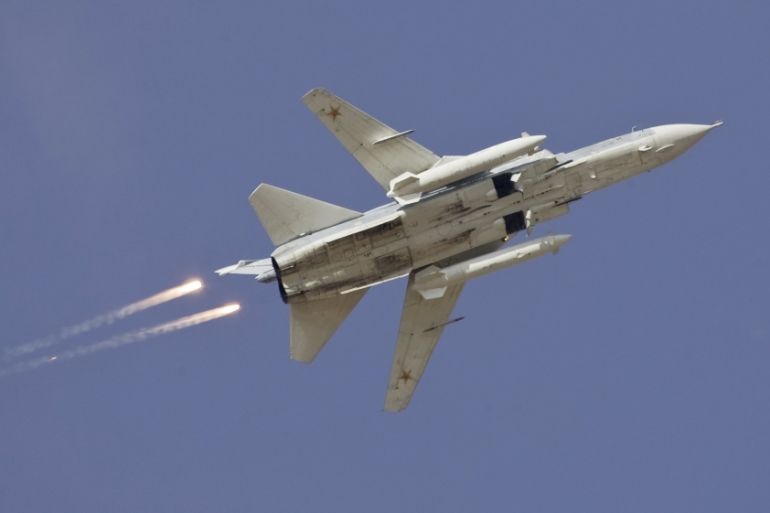Analysis: Downing of Russian jet hardly a surprise
Russia should not be surprised that one of its jets was shot down by Turkey near the Syrian border.

The shooting down of a Russian Air Force Sukhoi Su-24 jet by Turkish F-16 fighters after it reportedly violated Turkish airspace is a dangerous escalation in the context of Russia’s continuing confrontation with NATO in Eastern Europe and Syria.
However, it should not come as much of a surprise.
Keep reading
list of 4 itemsWorld Food Programme to end general assistance in northwest Syria
Erdogan open to meeting al-Assad but not to withdrawal from Syria
Middle East Roundup: What’s going on with Saudi Arabia and China?
Turkish authorities claim that the Su-24 fighter bomber ignored repeated warnings over the course of five minutes on Tuesday and was then shot down after violating Turkish airspace near Yayladagi, Hatay.
Russia claims that the Su-24 did not cross the Syria-Turkey border and was, therefore, illegally attacked.
|
|
This version of events, however, does not fit with an established pattern of repeated violations of NATO airspace by Russian military aircraft over the past 18 months.
In October 2014, and in June and July this year, for example, Russian military aircraft repeatedly violated Estonian airspace and since 2013 have also violated the airspace of NATO-partner nations Sweden and Finland.
On October 3 and 4, Russian Su-30SM and Su-24 jets violated Turkish airspace repeatedly in the same Hatay province where Turkey claims the Su-24 entered its airspace on Tuesday, before it was shot down.
During these October airspace violations, which Russia admitted, a Russian Su-30SM fighter actively locked on its radar to the Turkish F-16s sent to intercept it for over five minutes – an aggressive action outside of the accepted military procedures for such encounters.
Despite the provocative action, the Russian Ministry of Defence claimed that the violations of Turkish airspace on consecutive days were an accidental result of pilots getting lost.
This is not a credible explanation since modern combat aircraft such as the Su-30SM have sophisticated navigation systems and the Russian Air Force crews sent to Syria will be highly trained and selected, precisely because the operational environment is so congested and sensitive.
In terms of Tuesday’s incident, the multiple pieces of footage of the Su-24 falling in flames show a clear blue sky which would further aid navigation by visual means.
RELATED: NATO warns Russia after jet strays into Turkey
Russia has, in other words, been probing Turkey’s airspace and patience since October, and NATO airspace for much longer than that.
However, it should not come as a surprise that further violations would result in a plane being shot down.
Turkey has consistently responded to Syrian incursions by using its modern, US-supplied F-16 fighters to shoot down intruders.
In 2013, a Syrian Air Force Mi-17 helicopter and a Mig-23 fighter bomber were destroyed in two separate incidents after they entered Turkish airspace.
The Turkish Air Force shot down another Syrian Mig-23 in March 2014 after it ignored repeated warnings.
|
|
Furthermore, on October 16, a small drone of unknown nationality but suspected Russian origin was shot down in a similar fashion.
Syria has also previously shot down Turkish military aircraft which have entered Syrian airspace.
In other words, the airspace on the Syrian-Turkish border is a known high-tension front line where lethal force is regularly employed if warnings are ignored.
Within this context, the aggressive Russian Air Force actions in probing Turkish airspace and locking on to its fighters last month were treated with significant restraint by Turkey.
However, Turkey and NATO made it clear that such violations must stop and that any repetition would be “highly dangerous”.
If, as Turkey claims, the Su-24 shot down on Tuesday did violate Turkish airspace and ignore repeated warnings, it should not come as a surprise to either side that it was shot down, however destabilising the results may be.

Much will now depend on how convincingly Turkey and NATO can demonstrate that the Russian jet did indeed enter Turkish airspace, and how the tightly Kremlin-controlled Russian media chooses to spin the story for the Russian public.
Putin most likely knows that a routine provocation has, for once, been met with force and he has only his own policies to blame.
However, he cannot be seen to admit any such thing in public.
RELATED: Would a no-fly zone in Syria serve any purpose?
Therefore, he must continue to claim publicly that Turkey is villainously stabbing Russia in the back in the midst of her heroic battle against the Islamic State of Iraq and the Levant (ISIL) group.
The fact that there are no ISIL forces near that portion of the Syrian-Turkish border, and that the Su-24 was most likely engaged in continued Russian air strikes against Turkmen rebels fighting President Bashar al-Assad as part of the Free Syrian Army, will doubtless stay off the Russian script.
In any case, it is vital in the coming days that leaders on both sides try to avoid more inflammatory rhetoric and avoid further escalation.
With so many military forces pursuing their own, often conflicting, agendas in Syria and the wider region; the world cannot afford to risk brinkmanship over this incident.
Justin Bronk is a Research Analyst in Military Sciences at the Royal United Services Institute.
The views expressed in this article are the author’s own and do not necessarily reflect Al Jazeera’s editorial policy.